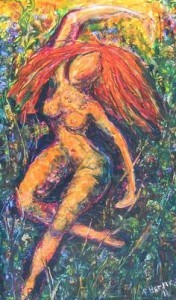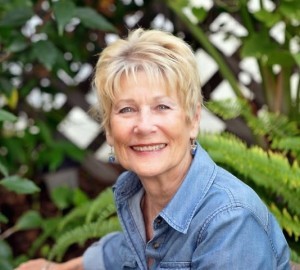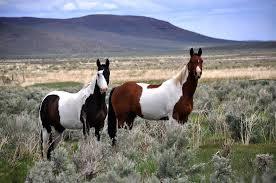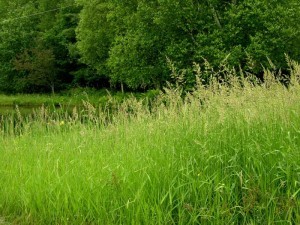Mary Reynolds Thompson's Blog, page 10
July 1, 2015
The Song of A Wild Soul Woman

Women are rising.
Wild, windswept, born of ocean, aflame with light, rooted as trees, we are rising.
We are re-wilding ourselves. Emerging from Earth, clad in moss and bark.
We are unrecognizable, except to each other.
We move in the shadows of forests and the deep, cool undercurrents of streams.
We reach out our arms to the mountains.
Dare to stand, cracked and dry and dust-whorled like deserts.
We green ourselves with grasses, root ourselves in moist soil.
We are wondrous. We are rising. We are wild.
We see each other, feel for each other, hold each other up.
Like waves in an ocean we are a celebration of nature’s powers and impulses.
We ebb and flow according to our own rhythm.
We will not be dictated to.
A woman no longer separate from the flesh of Earth, becomes her, speaks for her, lifts her throat
and sings of fire below and stars in her hair.
We are granite and grandeur,
full-fleshed and woven through with wildflowers.
We bloom according to our own ways and whims and wants.
False things fall down in our presence. We are pregnant with new birth.
A wild soul woman is a woman of belly and breath and boundlessness.
She makes her own way through ancient lands. With soft footsteps, lays down fresh tracks.
Barriers break apart before her.
Instinctively she moves, on fin and wing and prayer.
She listens to the wisdom of stone.
She is the echo of a deeper voice that speaks from the fiery cave.
She is molten, flowing, shape-shifter.
She is living proof of a language that banishes all sense of loneliness.
The Earth warms her, welcomes her, enfolds her.
She grows tall amid the fields, greets the wind and the grasses, the soft grace of rainbows.
She is fire woman and rain woman and earth and air, with plenty to spare.
This is not my song. This is the song of the Earth.
We are wondrous. We are rising. We are wild.
(c) Mary Reynolds Thompson
Whether you are a man or a woman, write your own Wild Soul Song.
Having written your Wild Soul Song, read it out loud to yourself. What surprises you, what do you notice? What would you have to change to live from your wild soul?
The post The Song of A Wild Soul Woman appeared first on Mary Reynolds Thompson.
Judy Reeve’s Wild Soul Story
 Judy Reeves is a writer, teacher, and writing practice provocateur who has written four books on writing, including the recently released Wild Women, Wild Voices and the award-winning A Writer’s Book of Days. In her Wild Soul Story she tells the story of a plum tree in the hills around San Diego that gifted her with insight into the deeper dimensions of the universe in all its wild connectivity and interrelatedness. Told with a writer’s eye, this story is as delicious in the savoring, as the juicy plum that inspired it. You can find more about Judy Reeves on her website or The Lively Muse Blog.
Judy Reeves is a writer, teacher, and writing practice provocateur who has written four books on writing, including the recently released Wild Women, Wild Voices and the award-winning A Writer’s Book of Days. In her Wild Soul Story she tells the story of a plum tree in the hills around San Diego that gifted her with insight into the deeper dimensions of the universe in all its wild connectivity and interrelatedness. Told with a writer’s eye, this story is as delicious in the savoring, as the juicy plum that inspired it. You can find more about Judy Reeves on her website or The Lively Muse Blog.
The post Judy Reeve’s Wild Soul Story appeared first on Mary Reynolds Thompson.
June 17, 2015
Love Poem
Rain smell comes with the wind
out of the southwest.
Smell of sand dunes
tall grass glistening
in the rain.
Warm raindrops that fall easy
(this woman)
The summer is born.
Smell of her breathing new life
damp sand.
small gray toads on
(this woman)
whispering to dark wide leaves
white moon blossoms dripping
tracks in the
sand.
Rain smell
I am full of hunger
deep and longing to touch
wet tall grass, green and strong beneath.
This woman loved a man
and she breathed to him
her damp earth song.
I am haunted by this story
I remember it in cottonwood leaves
the shade.
their fragrance in
I remember it in the wide blue sky
when the rain smell comes with the wind.
(C) Leslie Marmon Silko
From the anthology “Sisters of the Earth”
Tell about a day full of “rain smell” –what happened? Where were you?
“Love Poem” is so sensual and lush–Write a poem about a place in nature, allowing your sense of smell to lead you into lots more sensuous details.
The erotic appreciation of the Earth and passionate human love is intertwined in this poem. Do you have such a moment to write about?
The post Love Poem appeared first on Mary Reynolds Thompson.
June 16, 2015
Camille Dungy’s Wild Soul Story
 Camille Dungy is a poet and professor and author of three collections of poetry: Smith Blue, Suck on the Marrow, and What to Eat, What to Drink, What to Leave for Poison. She is also editor of Black Nature: Four Centuries of African American Nature Poetry. Her remarkable story takes place in the chaparral of Southern California when she is a very young child. In love with this vast and open landscape of prickly pear cactus, rocks, caves, and spiders, she learns to navigate its rewards and dangers, even as she feels its loss through encroachment by houses and roads. Her story is the story of all of us who have loved places and lost them, while never losing our willingness to remain open to nature’s beauty. To find out more about Camille Dungy and her remarkable work, please visit her website.
Camille Dungy is a poet and professor and author of three collections of poetry: Smith Blue, Suck on the Marrow, and What to Eat, What to Drink, What to Leave for Poison. She is also editor of Black Nature: Four Centuries of African American Nature Poetry. Her remarkable story takes place in the chaparral of Southern California when she is a very young child. In love with this vast and open landscape of prickly pear cactus, rocks, caves, and spiders, she learns to navigate its rewards and dangers, even as she feels its loss through encroachment by houses and roads. Her story is the story of all of us who have loved places and lost them, while never losing our willingness to remain open to nature’s beauty. To find out more about Camille Dungy and her remarkable work, please visit her website.
The post Camille Dungy’s Wild Soul Story appeared first on Mary Reynolds Thompson.
Judy Reeves’ Wild Soul Story

Judy Reeves is a writer, teacher, and writing practice provocateur who has written four books on writing, including the recently released Wild Women, Wild Voices and the award-winning A Writer’s Book of Days. In her Wild Soul Story she tells the story of a plum tree in the hills around San Diego that gifted her with insight into the deeper dimensions of the universe in all its wild connectivity and interrelatedness. Told with a writer’s eye, this story is as delicious in the savoring, as the juicy plum that inspired it. You can find more about Judy and her work and books on her website. And you can read her Lively Muse blog here.
The post Judy Reeves’ Wild Soul Story appeared first on Mary Reynolds Thompson.
June 10, 2015
The Old One and the Wind
She loves the wind.
There on the edge of the known world, at ninety,
In her tall house, any wildness in the elements
Is as welcome as an old friend.
When the surgically patched elms and sycamores
Crack off their heavy limbs in the freak snow storm
Of October, she rejoices; the massy hail
That drives craters into her groomed lawn
Stirs her sluggish heart to a riot of beating.
A cluster of cottonwood trees in the swale
Of the prairie, oasis now in a desert of wheat fields,
Is all that is left of the home place. No one
Is left to remember the days there with her:
The playhouse sheltered behind the cowshed,
The whirlwinds that made a column of corn shucks,
Winters when snow brushed out all the fences,
Springs when the white of the snow turned to daisies,
Wind-bent as were the urchins who picked them.
To her in the tall house in the tame town, the wind
That escapes the windbreaks of man’s constructing
Blows from a distance beyond the young’s conceiving,
Is rife with excitements of the world’s beginning
And its end.
(C) Clarice Short
After reading aloud “The Old One and the Wind,” write a poem that begins with “I love the wind…” Allow the words to blow you where they will!
In what ways is your life too tame? In what ways does the wild call to you?
Write about a time you experience a wild weather event–a snow storm, a high wind, a thunderous sky. Write about it in the first person, present tense, “I am…” After you’ve completed your piece, reflect back on what it tells you about your own relationship to wildness.
The post The Old One and the Wind appeared first on Mary Reynolds Thompson.
May 27, 2015
A Blessing

Just off the highway to Rochester, Minnesota,
Twilight bounds softly forth on the grass.
And the eyes of those two Indian ponies
Darken with kindness.
They have come gladly out of the willows
To welcome my friend and me.
We step over the barbed wire into the pasture
Where they have been grazing all day, alone.
They ripple tensely, they can hardly contain their happiness
That we have come.
They bow shyly as wet swans. They love each other.
There is no loneliness like theirs.
At home once more,
They begin munching the young tufts of spring in the darkness.
I would like to hold the slenderer one in my arms,
For she has walked over to me
And nuzzled my left hand.
She is black and white,
Her mane falls wild on her forehead,
And the light breeze moves me to caress her long ear
That is delicate as the skin over a girl’s wrist.
Suddenly I realize
That if I stepped out of my body I would break
Into blossom.
(C) James Wright
The poet describes a simple and tender moment––A Blessing–– of interacting with two horses, and then in an abrupt shift, allows us to recognize the blossoming of his own happiness from this simple encounter. Write a piece, prose or poem, that explores the relationship between outer nature and your inner emotional field.
Describe one way in which nature blesses you. As you write your piece, allows gratitude for the beauty of the world to fill you.
The post A Blessing appeared first on Mary Reynolds Thompson.
Seeking Solace in Wild Places
One of my favorite books of all time is The Wild Places by Robert Macfarlane. In the chapter “Moors”, he recounts the story of the mountaineer W.H. Murray, who first ventured into the Highlands of Scotland in 1933, when he was nineteen. The wildness of the Scottish Highlands would quickly assume for Murray, “a near mystical importance; it would also, though he was not then to know it, save him from madness.”
Taken captive by the Germans during World War II, he became a prisoner of war at the Chieti Camp in north Italy, from where he could gaze out at the Abruzzi mountain range, a blue and white ghost floating in the sky. Mountains came to symbolize “freedom” for Murray. And in secret, on scraps of toilet paper, he began to write about his precious Highlands. Confined as he was, Murray imagination reached out to “high plateau and long rides and wide moors.”
Even after being transferred to Moosburg camp in Bavaria, a hell-hole of cramped conditions, wire fences, fleas and lice, still he wrote about his beloved highlands. Weak and skeletal, he despaired of ever being fit enough to climb again his precious mountains. And yet his starved body seemed to release its grip on his imagination so that “When he closed his eyes, the mountain and glens sprang to mind, vivid in every detail.”
During the final year of his incarceration he recalled, “I had not once thought of myself as imprisoned. I lived on mountains, and had the freedom of them.”
On May Day 1945, Murray’s prison camp was liberated by American troops. A month later, he dragged his weak and emaciated body up his beloved Buachaille, where he gazed out at those wide-open spaces that had captured his soul before the war “with all the suddenness of a conversion of faith.”
As Macfarlane shows us, through his recounting of Murray’s story, our relationship with certain places can evoke passionate feelings. Places can shape who we are––even save us from madness when our lives are in shambles. And yet, how often do we take the time to really dwell on our relationship to place? What would happen if we did?
It seems to me that a strong bond with a place involves a deepening and strengthening of identity, so that we allow that special place to become part of us, as if the land itself was reclaiming us, much as ivy takes over a wall or the wind scours the mountaintops.
So what is the place you carry within you that can see you through the tough times? What about that place draws you? Strengthens you? Is a part of you?
Do you seek solace in wild places? Share your story below.
To explore your relationship with place in imaginative and creative ways please join me and colleague Kate Thompson in Colorado in July for two workshops: Literature, Landscape & Imagination and A Sense of Place.
The post Seeking Solace in Wild Places appeared first on Mary Reynolds Thompson.
May 7, 2015
Jodi Sky Roger’s Wild Soul Story

South African eco-intuitive and writer Jodi Sky Rogers, and author of Wild Essence: Return to the Peace and Freedom of Your Inner Wilderness, takes us into the hills of South Africa for her Wild Soul Story. There, at the age of 12, she felt the energy of the earth rising through her showing her the history of the land. Called to explore the hillsides, she follows her intuition and encounters a huge owl, “the most humongous” she has ever seen. Jodi and the owl look into each others’ souls, and Jodi’s path in life is forever changed. You can find more about Jodi and her work from her website.
The post Jodi Sky Roger’s Wild Soul Story appeared first on Mary Reynolds Thompson.
The Sun
This morning on the desk,
facing up,
a poem of Kavenagh’s
celebrating a lost love.
“She was the sun,” he said,
lives in the fibre
of his arms,
her warmth
through all the years
folding the old man’s hand
in hers
of a Sunday
Dublin morning.
Sometimes reading
Kavenagh I look out
at everything
growing so wild
and faithfully beneath
the sky
and wonder
why we are the one
terrible
part of creation
privileged
to refuse our flowing.
I know
in the text of the heart
the flower is our death
and the first opening
of the new life
we have yet to imagine,
but Kavenagh’s line
reminds me
how I want to know
that sun,
and how I want to flower
and how I want to claim
my happiness
and how I want to walk
through life
amazed and inarticulate
with thanks.
And how I want to
know that warmth
through
love itself,
and
through the sun itself.
I want to know
that sun
of happiness
when I wake
and see through
my window
the morning color
on the far mountain.
I want to know
when I lean down to the lilies
by the water
and feel their small and
perfect reflection
on my face.
I want to know
that gift
when I walk
innocent through the trees
burning with life
and the green
passion
of the pasture’s
first growth,
and I want to know
as lazily
as the cows
that tear at the grass
with their
soft mouths.
I want to know
what I am
and what I am
involved with by loving
this world
as I do.
And I want time
to think of all
the unlived lives:
those that fail to notice
until it is too late,
those with eyes staring
with bitterness,
and those
met on the deathbed
whose mouths are wide
with
unspoken love.
Every year
they keep me faithful
and help me
realize there is more
to lose
than I thought
and more at stake
than I could dream.
(C) David Whyte
Are you refusing your own flowering? If so, how? If you could embrace it what would change?
The poet repeats the refrain, “I want to know…” What is it that you want to know? Write a list of ten things you’re curious about. What do you notice about your list?
Write a poem or a prose piece about what’s at stake? What is it that you don’t want to lose?
The post The Sun appeared first on Mary Reynolds Thompson.






